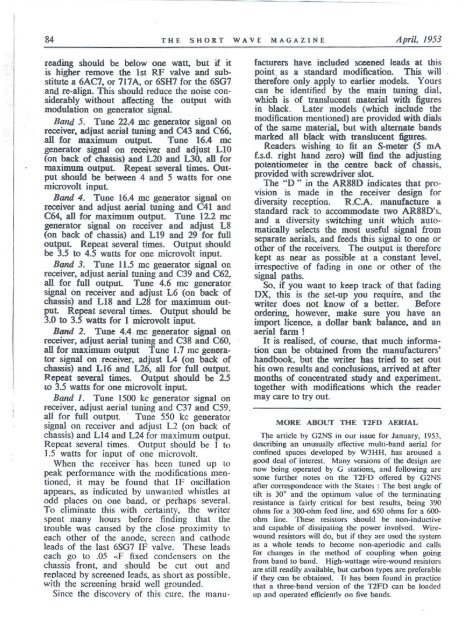Getting the Utmost From the AR-88.pdf
Getting the Utmost From the AR-88.pdf
Getting the Utmost From the AR-88.pdf
- No tags were found...
Create successful ePaper yourself
Turn your PDF publications into a flip-book with our unique Google optimized e-Paper software.
84 THE SHORT WAVE MAGAZINE April. 1953reading should be below one watt. but if itis higher remove <strong>the</strong> 1st RF valve and substitutea 6AC7. or 717A. or 6SH7 for <strong>the</strong> 6SG7and re-align_ This should reduce <strong>the</strong> noise considerablywithout alIecting <strong>the</strong> output withmodulation on generator signal.Band 5. Tune 22.4 mc generator signal onreceiver. adjust aerial tuning and C43 and C66.all for maximum output. Tune 16.4 mcgenerator signal on receiver and adjust LlO(on back of chassis) and L20 and L30. all formaximum output. Repeat several times. Outputshould be between 4 and 5 watts for onemicrovolt input.Band 4. Tune 16.4 mc generator signal onreceiver and adjust aerial tuning and C41 andC64. all for maximum output. Tune 12.2 megenerator signal on receiver and adjust L8(on back of chassis) and Ll9 and 29 for fulloutput. Repeat several times. Output shouldbe 3.5 to 4.5 watts for one microvolt input.Band 3_ Tune 11.5 me generator signal onreceiver. adjust aerial tuning and C39 and C62.all for full output. Tune 4.6 me generator.signal on receiver and adjust L6 (on back ofchassis) and Ll8 and L28 for maximum output.Repeat several times. Output should be3_0 to 3.5 watts for 1 microvolt input.Band 2. Tune 4.4 . mc generator ' signal onreceiver. adjust aerial tuning and C38 and C60,all for maximum output Tune 1.7 me generatorsignal on receiver. adjust L4 (on back ofchassis) and Ll6 and L26, all for full output.Repeat several times. Output should be 2.510 3.5 watts for one microvolt input.Band 1. Tune 1500 kc generator signal onreceiver. adjust aerial tuning and C37 and C59.all for full output. Tune 550 kc generatorsignal on receiver and ad just L2 (on back ofchassis) and L14 and L24 for maximum output.Repeat several times. Output should be I to1.5 watts for input of one microvolt.When <strong>the</strong> receiver ' has been tuned up topeak performance with <strong>the</strong> modifications mentioned.it may be found that IF oscillationappears. as indicated by unwanted whistles atodd places on one band, or perhaps several.To eliminate this with certainty, <strong>the</strong> writerspent many hours before finding that <strong>the</strong>trouble was caused by <strong>the</strong> close proximity toeach o<strong>the</strong>r of <strong>the</strong> anode, screen and cathodeleads of <strong>the</strong> last 6SG7 IF valve. These leadseach go to .05 ... F fixed condensers on <strong>the</strong>chassis front. and should be cut out andrenlaced by screened leads. as short as possible.with <strong>the</strong> screening braid well grounded.Since <strong>the</strong> discovery of this cure, <strong>the</strong> manufacturershave included secened leads at thispoint . as a standard modification. This will<strong>the</strong>refore only apply to earlier models. Yourscan be identified by <strong>the</strong> main tuning dial.which is of translucent material with figuresin black. Later models (which include <strong>the</strong>modification mentioned) are provided with dialsof <strong>the</strong> same material. but with alternate bandsmarked all black with translucent figures.Readers wishing to fit an S-meter (5 mAf.s.d. right hand zero) will find <strong>the</strong> adjustingpotentiometer in <strong>the</strong> centre back of chassis.provided with screwdriver slot.The "0" in <strong>the</strong> <strong>AR</strong>880 indicates that provisionis made in <strong>the</strong> receiver design fordiversity reception. R.C.A. manufacture astandard rack to accommodate two <strong>AR</strong>88D's.and a diversity switching unit which automaticallyselects <strong>the</strong> most useful signal fromseparate aerials, and feeds this signal to one oro<strong>the</strong>r of <strong>the</strong> receivers. The output is <strong>the</strong>reforekept as near as possible at a constant level,irrespective of fading in one or o<strong>the</strong>r of <strong>the</strong>signal paths.So, if you want to keep track of that fadingOX, this is <strong>the</strong> set-up you require. and <strong>the</strong>writer does not know of a better. Beforeorderin,g. however, make sure you have animport licence, a dollar bank balance. and anaerial farm !It is realised. of course. that much informationcan be obtained from <strong>the</strong> manufacturers'handbook, but <strong>the</strong> writer has tried to set outhis own results and conclusions, arrived at aftermonths of concentrated study and experiment.toge<strong>the</strong>r with modifications which <strong>the</strong> readermay care to try out.MORE ABOUT THE TIFD AERIALT}le article by G2NS in our issue for January, 1953.describing an unusually effective multi-band aerial forconfined spaces developed by W3HH. has aroused agood deal of interest. Many versions of <strong>the</strong> design arenow being operated by G stations, and following aresome fur<strong>the</strong>r notes on <strong>the</strong> TIFD offered by G2NSafter correspondence with <strong>the</strong> States: The best angle oftilt is 30° and <strong>the</strong> optimum value of <strong>the</strong> terminatingresistance is fairly critical for best results, being 390ohms for a 300-0hm feed line. and 650 ohms for a 600-ohm line. These resistors should be non-inductiveand capable of dissipating <strong>the</strong> power involved. Wirewoundresistors will do, but if <strong>the</strong>y are used <strong>the</strong> systemas a whole tends to become non-aperiodic and calJsfor changes in <strong>the</strong> method of coupling when goingfrom band to band. High-wattage wire-wound resistorsare still readily available, but carbon types are preferableif <strong>the</strong>y can be obtained. It has been found in practicethat a three-band version of <strong>the</strong> T2FD can be loadedup and operated efficiently on five bands.

















